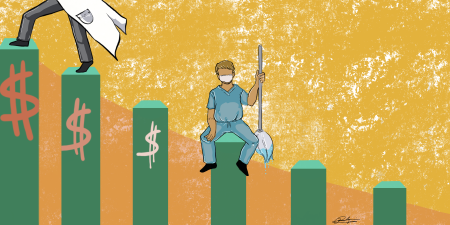Abstract
The COVID-19 pandemic has revealed a great irony in the labor market: workers essential to social functioning and safety are among the least valued by pay. Support workers (eg, medical assistants), direct care workers (eg, nursing assistants and personal care aides), and service workers (eg, janitors and food preparers) have long experienced wage theft and exploitation, although health care organizations would cease functioning without them. The health sector has opportunities to revisit wage hierarchies and to ensure living wages for these workers.
Individuality and Meritocracy
In his book, What We Owe to Each Other, the philosopher T.M. Scanlon tries to answer the question of when we can expect people living in a society to be duty bound to each other. His answer is that we must justify our duties to others based on principles that we cannot reasonably reject.1 In other words, we must have reasons for our moral decisions, and those reasons must withstand collective scrutiny. His theory presupposes that we owe each other something—or at least recognizes that society would hardly function if we did not act like we did. While this reasoning might seem self-evident to some, our public discourse often assumes the exact opposite. Americans’ devotion to rugged individualism often leads to the conclusion that we are responsible only for ourselves. Our faith in meritocracy leads us to believe that individuals’ success or failure belongs to them and them alone. But the COVID-19 pandemic has forced a reckoning with these quintessentially American ideas, presented us with problems that cannot be solved by individuals, and revealed a great irony about social hierarchies created by meritocratic ideals: workers essential to social functioning and safety are among the least respected and lowest paid.
In the health sector, all workers are essential, but not all workers are treated—or paid—equally. Support workers (eg, medical assistants), direct care workers (eg, nursing assistants and personal care aides), and service workers (eg, janitors and food preparation staff) have long suffered from low wages, high rates of wage theft, and labor exploitation. Yet health care organizations would cease to function without them, a fact that became abundantly clear during the COVID-19 pandemic. Health care workers earning low wages saved countless lives during the pandemic at the risk of their own health, well-being, and sometimes their lives. What do we—health care employers, patients, and society at large—owe them now?
Wage Theft in Health Care
Based on how much some health care workers are paid, it appears that we believe we do not owe them very much. One study found that the median wage in 2019 for home health aides, for example, was $11.57 per hour.2 The median hourly wage in 2019 of all health care support, service, and direct care workers was $13.48 per hour,2 less than the $15 an hour demanded by living wage campaigns,3 and well below the median wages in 2019 of nurses ($35.17 per hour) and doctors (more than $100 per hour).2 These wages are only slightly higher than the minimum wage that employers must pay in most states, which ranges from $7.25 per hour in 21 states to $15.20 per hour in the District of Columbia.4 In 2017, 15% of direct care workers lived below 100% of the federal poverty level, and 42% relied on public assistance to make ends meet.5 These data suggest that the value of many health care workers’ compensation is incommensurate with the value of their contributions.
Wage theft is rampant in many industries, including in health care.6 A 2009 study found that 12% of home health aides make less than the minimum wage.7 Many others are paid a fixed sum for a variable number of hours, which leads to frequent minimum wage and overtime violations. Despite several recent lawsuits against hospital systems,8,9,10 lawsuits to recover wages are the exception, not the rule. Most workers never recover wages stolen from them by employers because those workers do not have access to legal representation, are worried about retaliation, or don’t know their employers are stealing from them.6,11 Wage theft costs health care workers millions of dollars per year in lost income.12
Burnout
Pay is not the only problem for these workers. They also struggle with unsanitary or unsafe working conditions and a lack of respect from their employers and supervisors. In 2018 and 2019, I led a team that interviewed home health aides in Buffalo, New York, and surrounding areas about their pay and working conditions.13 The workers recounted verbal abuse, sexual harassment, bug and rodent infestations, and lack of personal protective equipment, such as gloves and masks. They were often required to provide care that they were not trained to provide or expected to do tasks that were not in their job description, such as cleaning and running errands. The workers complained of irregular schedules, not being paid overtime, having no paid leave, and job insecurity.
Wage theft costs health care workers millions of dollars per year in lost income.
Many aides felt pride in the care they were able to provide, but fewer than half saw themselves staying in the job for more than 5 years.13 The work was too hard, their employers too disrespectful, and the pay too low for them to consider their work as a long-term career. This lack of respect affects many health care workers at the bottom of the income scale. According to one survey, doctors and nurses enjoy among the highest levels of occupational prestige, while health care support, service, and direct care workers suffer from the lowest levels.14 When workers do not feel respected, they are more likely to experience burnout and leave their jobs.
All of these issues have been exacerbated by the pandemic. Essential workers in all fields have reported higher rates of stress and burnout, and the pandemic has hit health care workers earning low wages particularly hard.15 More than half a million health care workers quit in August 2021, a 20-year high.16 Labor strikes are on the rise, as health care workers have become fed up with their pay and working conditions.17 Hospitals cannot find enough workers to fill positions in an industry that is only expected to grow over the next 20 years.18 A rising need for workers at the same time that many workers have opted out is a recipe for disaster. As baby boomers continue to age, who will care for them when the pandemic is over?
Rendering What We Owe
The health care sector may be reaching a point at which it can no longer ignore how workers are treated. Employers have justified low wages and poor working conditions because these positions require less formal education. But it is not reasonable to deny someone a living wage or a safe workplace solely because the training they need for the job does not come with a fancy degree. That mindset has created the situation we are now in. It is not sustainable or defensible.
An obvious solution to this problem is to pay workers more and ensure that they have access to safe and sanitary workplaces, humane schedules, and adequate benefits, which would incentivize many to stay in their jobs. Employers might be forced to make some of these changes themselves, given worker shortages. Policymakers should also step in with policy interventions, such as raising the minimum wage and mandating certain working conditions and benefits. Such changes will require wages and benefits reallocation up and down the wage hierarchy, as well as an infusion of public funds. Government can also fund programs to ensure that enough workers are well trained to provide high-quality care to everyone and can authorize more employment-based visas for international health care workers. In order to make these important investments, all of us—regardless of whether we work in the health sector—must prioritize health care workers.
Health care workers have also begun demanding more. The pandemic has sparked a wave of unionization across the health care sector,19 and community organizations, such as the National Domestic Workers Alliance, have used the pandemic to draw attention to the plight of some of the most vulnerable health care workers—people who work in private homes.20 The pandemic provides the health care sector with opportunities to revisit wage hierarchies and ensure living wages for the lowest-paid workers. It allows us to do more than applaud the sacrifices these workers made during the pandemic by treating even the lowest paid workers with respect. The pandemic has been a reminder that we are all connected. Rejecting our obligations to others not only is morally bankrupt but also negatively affects the quality of care we will all need at some point in our lives. We owe each other more, and the time has come for change.
References
-
Scanlon TM. What We Owe Each Other. Harvard University Press/Belknap Press; 1998.
-
Kinder M. Essential but undervalued: millions of health care workers aren’t getting the pay or respect they deserve in the COVID-19 pandemic. Brookings Institution. May 28, 2020. Accessed October 26, 2021. https://www.brookings.edu/research/essential-but-undervalued-millions-of-health-care-workers-arent-getting-the-pay-or-respect-they-deserve-in-the-covid-19-pandemic
-
Rushe D. “Hopefully it makes history”: fight for $15 closes in on mighty win for US workers. Guardian. February 13, 2021. Accessed April 13, 2021. https://www.theguardian.com/us-news/2021/feb/13/fight-for-15-minimum-wage-workers-labor-rights
-
States with the highest and lowest minimum wages in 2022. Minimum-Wage.org. Accessed April 21, 2022. https://www.minimum-wage.org/highest-and-lowest-minimum-wages
-
Scales K. It’s time to care: a detailed profile of America’s direct care workforce. PHI; 2020.
-
Hallett N. The problem of wage theft. Yale Law Policy Rev. 2018;37:93-152.
-
Bernhardt A, Milkman R, Theodore N, et al. Broken Laws, Unprotected Workers: Violations of Employment and Labor Laws in America’s Cities. National Employment Law Project; 2009. Accessed October 26, 2021. https://www.nelp.org/wp-content/uploads/2015/03/BrokenLawsReport2009.pdf
-
Globe staff. CareGroup, staffers settle pay lawsuit. Boston Globe. June 9, 2010. Accessed October 26, 2021. http://archive.boston.com/business/healthcare/articles/2010/06/09/caregroup_staffers_settle_pay_lawsuit
-
Gale K. Hospital employees reach $9.5M settlement over unpaid training at work. Top Class Actions. November 28, 2017. Accessed October 26, 2021. https://topclassactions.com/lawsuit-settlements/lawsuit-news/825933-hospital-employees-reach-9-5m-settlement-over-unpaid-training-at-work
-
California Labor Commissioner’s citations of $8.5 million issued to owner of six residential care facilities upheld. News release. Department of Industrial Relations; October 20, 2021. Accessed Oct. 26, 2021. https://www.dir.ca.gov/DIRNews/2021/2021-105.html
-
Weil D, Pyles A. Why complain? Complaints, compliance, and the problem of enforcement in the US workplace. Comp Labor Law Policy J. 2006;27:59-92.
-
Cooper D, Kroeger T. Employers steal billions from workers’ paychecks each year. Economic Policy Institute. May 10, 2017. Accessed October 27, 2021. https://www.epi.org/publication/employers-steal-billions-from-workers-paychecks-each-year
-
Hallett N, Pelfrey-Duryea D. Homecare Industry in Crisis. Patients and Workers Both Suffer Under Current Industry Practices. University at Buffalo School of Law; 2019.
-
Van Drie H, Reeves RV. Many essential workers are in “low-prestige” jobs. Time to change our attitudes—and policies? Up Front blog. May 28, 2020. Accessed October 26, 2021. https://www.brookings.edu/blog/up-front/2020/05/28/many-essential-workers-are-in-low-prestige-jobs-time-to-change-our-attitudes-and-policies
-
Berg S. Half of health workers report burnout amid COVID-19. American Medical Association. July 20, 2020. Accessed October 26, 2021. https://www.ama-assn.org/practice-management/physician-health/half-health-workers-report-burnout-amid-covid-19
-
Al-Arshani S. Over 500,000 healthcare workers quit in August and thousands more have gone on strike as the industry deals with burnout and staff shortages. Business Insider. October 23, 2021. Accessed October 26, 2021. https://www.businessinsider.com/thousands-healthcare-workers-quitting-striking-burnout-grows-staff-shortages2021-10
-
Kallas J, Grageda L, Friedman E. Labor action tracker: annual report 2021. Worker Institute blog. February 21, 2022. Accessed April 13, 2022. https://www.ilr.cornell.edu/worker-institute/blog/reports-and-publications/labor-action-tracker-annual-report-2021
-
Romero L, Bhatt J. Pandemic has made shortage of health care workers even worse, say experts. ABC News. May 21, 2021. Accessed January 28, 2022. https://abcnews.go.com/US/pandemic-made-shortage-health-care-workers-worse-experts/story?id=77811713
-
Pattani A. For health care workers, the pandemic is fueling renewed interest in unions. NPR. January 11, 2021. Accessed February 23, 2022. https://www.npr.org/sections/health-shots/2021/01/11/955128562/for-health-care-workers-the-pandemic-is-fueling-renewed-interest-in-unions
-
National Domestic Workers Alliance. Accessed February 23, 2022. https://www.domesticworkers.org



